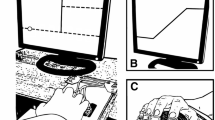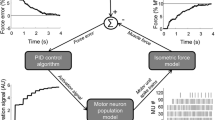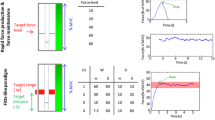Summary
This experiment examined the preparation and the production of isometric force in Parkinson's disease (PD). PD patients, elderly, and young subjects generated force levels that were a percentage of their maximum (15, 30, 45, and 60%). Subjects were cued on the upcoming target force level and they were asked to produce the required response as fast as possible. PD patients showed a similar progression of force variability and dispersion of peak forces to that of control subjects, implying they have an accurate “internal model” of the required forces. Force production impairments were seen, however, at the within-trial level. PD patients had more irregular force-time curves that were characterized by changes in the rate of force production. The results suggest a more “noisy” output from the motor system and an inability to produce smooth forces. PD patients were also substantially slower in initiating a force production and the delay was localized in the pre-motor reaction time.
Similar content being viewed by others
References
Abbs JH, Hartman DE, Vishwanat B (1987) Orofacial motor control impairment in Parkinson's disease. Neurology 37: 394–398
Bendat JS, Piersol AG (1971) Random data: analysis and measurement procedures. Wiley, London
Berardelli A, Accornero N, Argenta M, Meco G, Manfredi M (1986) Fast complex arm movements in Parkinson's disease. J Neurol Neurosurg Psychiat 49: 1146–1149
Berardelli A, Dick JPR, Rothwell JC, Day BL, Marsden CD (1986) Scaling of the size of the first agonist EMG burst during rapid wrist movements in patients with Parkinson's disease. J Neurol Neurosurg Psychiat 49: 1273–1279
Bloxham CA, Mindel TA, Frith CD (1984) Initiation and execution of predictable and unpredictable movements in Parkinson's disease. Brain 107: 371–384
Carlton L, Carlton MJ, Newell KM (1987) Reaction time and response dynamics. Q J Exp Psychol 39A: 337–360
Cooke JD, Brown JD, Brooks VB (1978) Increased dependence on visual information for movement control in patients with Parkinson's disease. Cand J Neurol Sci 5: 413–415
Darling WG, Cooke JD (1987) Changes in the variability of movement trajectories with practice. J Motor Behav 19: 291–309
Dietz V, Hillesheimer W, Freund H-J (1974) Correlation between tremor, voluntary contraction, and firing pattern of motor units in Parkinson's disease. J Neurol Neurosurg Psychiat 37: 927–937
Draper IT, Johns RJ (1964) The disordered movement in parkinsonism and the effect of drug treatment. Bull Johns Hopkins Hosp 115: 465–480
Evarts EV, Teravainen H, Calne DB (1981) Reaction time in Parkinson's disease. Brain 104: 167–186
Fitts PM (1954) The information capacity of the human motor system in controlling the amplitude of movements. J Exp Psychol 47: 381–391
Flash T, Hogan N (1985) The coordination of arm movements: an experimentally confirmed mathematical model. J Neurosci 5: 1688–1703
Frith CD, Bloxham CA, Carpenter KV (1986) Impairments in the learning and performance of a new manual skill in patients with Parkinson's disease. J Neurol Neurosurg Psychiat 49: 661–668
Flowers KA (1976) Visual ‘closed-loop’ and ‘open-loop’ characteristics of voluntary movements in patients with parkinsonism and intention tremor. Brain 99: 269–310
Gordon J, Ghez C (1987) Trajectory control in targeted force impulses. II. Pulse height control. Exp Brain Res 67: 241–252
Hallett M, Khoshbin S (1980) A physiological mechanism of bradykinesia. Brain 115: 465–480
Hancock PA, Newell KM (1985) The movement speed-accuracy relationship in space-time. In: Heuer H, Kleinbeck U, Schmidt KH (eds) Motor behavior: programming, control, and acquisition. Springer, Berlin, pp 153–188
Hayashi A, Kagamihara Y, Nakajima Y, Naragayashi H, Okuma Y, Tanaka R (1988) Disorder in reciprocal innervation upon initiation of voluntary movement in patients with Parkinson's disease. Exp Brain Res 70: 437–440
Heilman KM, Bowers D, Watson RT, Greer M (1976) Coordination of manual, postural, and locomotor movements during simple goal-directed motor tasks in parkinsonian off and on states. In: Yahr MD, Bergmann MJ (eds) Advances in neurology. Raven Press, New York, pp 375–382
Marsden CD (1982) The mysterious motor function of the basal ganglia: the Robert Wartenberg lecture. Neurology 32: 514–539
Marsden CD (1984) Function of the basal ganglia as revealed by cognitive and motor disorders in Parkinson's disease. Cand J Neurol Sci 11: 129–135
Marsden CD (1985) Defects of movement in Parkinson's disease. In: Delwaide PJ, Agnoli A (eds) Clinical neurophysiology in parkinsonism. Elsevier Science Publishers, Amsterdam, pp 107–115
Milner-Brown HS, Fisher MA, Weiner J (1979) Electrical properties of motor units in parkinsonism and a possible relationship with bradykinesia. J Neurol Neurosurg Psychiat 42: 35–41
Nelson W (1983) Physical principles for economics of skilled movements. Biol Cybern 46: 135–147
Newell KM, Carlton LG, Hancock PA (1984) Kinetic analysis of response variability. Psychol Bull 96: 133–151
Pullman SL, Watts RL, Juncos JL, Chase TN, Sanes JN (1988) Dopaminergic effects on simple and choice reaction time performance in Parkinson's disease. Neurology 38: 249–254
Salthouse TA (1979) Adult age and the speed-accuracy trade-off. Ergonomics 22: 811–821
Sanes JN (1985) Information processing deficits in Parkinson's disease during movement. Neuropsychologia 23: 381–392
Schmidt RA, Zelaznik HN, Hawkins B, Frank JS, Quinn JT (1979) Motor-output variability: a theory for the accuracy of rapid motor acts. Psychol Rev 86: 415–441
Schomaker LRB, Thomassen AJWM (1986) On the use and limitations of averaging handwriting signals. In: Kao HSR, van Galen GP, Hoosain R (eds) Graphonomics: contemporary research in handwriting. North-Holland, Amsterdam, pp 225–238
Sheridan MR, Flowers KA, Huller J (1987) Programming and execution of movement in Parkinson's disease. Brain 110: 1247–1271
Stelmach GE, Worringham CJ (1987) The preparation and production of isometric force in Parkinson's disease. Neuropsychologia 26: 93–103
Stelmach GE, Worringham CJ, Strand EA (1986) Movement preparation in Parkinson's disease: the use of advance information. Brain 109: 1179–1194
Stelmach GE, Worringham CJ, Strand EA (1987) The planning and execution of movement sequences in Parkinson's disease. Int J Neurosci 36: 55–65
Stern Y (1986) Patients with Parkinson's disease can employ a predictive motor strategy. J Neurol Neurosurg Psychiat 49: 107–108
Stern Y, Mayeux R (1986) Intellectual impairment in Parkinson's disease. In: Yahr MD, Bergmann KJ (eds) Advances in neurology. Raven Press, New York, pp 405–408
Tanji J, Taniguchi K, Saga T (1980) Supplementary motor area: neuronal response to motor instructions. J Neurophysiol 43: 60–68
Teasdale N, Stelmach GE (1988) Movement disorders: the importance of the movement context. J Motor Behav (in press)
Walter CB (1984) Temporal quantification of electromyography with reference to motor control research. Hum Mov Sci 3: 155–162
Welford AT (1958) Ageing and human skill. Oxford University Press, Oxford
Yokochi F, Nakamura R, Narabayashi H (1985) Reaction time of patients with Parkinson's disease, with reference to asymmetry of neurological signs. J Neurol Neurosurg Psychiat 48: 702–705
Author information
Authors and Affiliations
Additional information
This work was supported by grant NS17421 from the NIH
Rights and permissions
About this article
Cite this article
Stelmach, G.E., Teasdale, N., Phillips, J. et al. Force production characteristics in Parkinson's disease. Exp Brain Res 76, 165–172 (1989). https://doi.org/10.1007/BF00253633
Received:
Accepted:
Issue Date:
DOI: https://doi.org/10.1007/BF00253633




